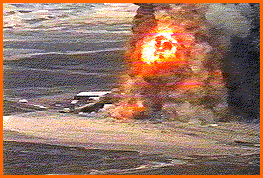![]()
Motivation
Heat transfer fluids (HTFs) are
extensively used in the chemical process industry and
are available in a wide range of properties. During
a recent 10-year period, however, 54 fires and explosions
and $150 million losses caused by HTFs fires have been
reported by Factory Mutual Engineering and Research. |
|
Rocket Fuel Plant Explosion-
Nevada |
Above their flash points, the vapors of HTFs are flammable and can cause explosions. To prevent significant vapor from forming, heat transfer fluids are used at elevated pressures. If loss of containment does occur, however, HTFs will leak under pressure and can disperse as an aerosol. Though it has been recognized that aerosols can explode, very little is known about their flammability. Therefore, research is critically needed to measure aerosol properties, including flammability. To help meet this need, research has begun a study of aerosols forming from HTFs. |
|
|

